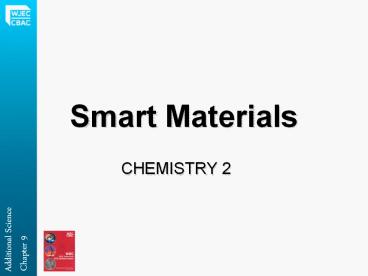Smart Materials - PowerPoint PPT Presentation
Title:
Smart Materials
Description:
Additional Science Smart Materials Chapter 9 CHEMISTRY 2 Smart Materials CHEMISTRY 2 Smart materials are new materials with properties that change reversibly with a ... – PowerPoint PPT presentation
Number of Views:65
Avg rating:3.0/5.0
Title: Smart Materials
1
Smart Materials
- CHEMISTRY 2
Additional Science
Chapter 9
2
Smart materials are new materials with properties
that change reversibly with a change in the
materials surroundings e.g. mechanical
deformation and changes in temperature, light and
pH.
Name of Smart Material Explanation Use
Shape memory polymers These are somewhere between thermoplastics and thermosets. When heated the polymer softens and it can be stretched and deformed. On cooling it remains in the deformed state. On being reheated it remembers and returns to its original shape. Plastic car bodies from which a dent could be removed by heating. Medical sutures that will automatically adjust to the correct tension and be biodegradable, not having to be surgically removed.
Thermochromic paints and pigments Organic molecules in ink and paint that change colour as a result of temperature change. Print on T-Shirts that change colour with temperature. Mugs whose colour indicates the temperature of the liquid inside.
Photochromic paints and pigments Organic molecules in ink and paint that change colour as a result of light (especially UV). The light breaks bonds and the atoms are rearranged to form molecules of different colour. Sunglasses which react to changing light intensity. Maybe photochromic molecules will be used to store data in 3D form in future.
Shape-memory alloys Some alloys, in particular some nickel/ titanium and copper/ aluminium/ nickel have two remarkable properties pseudo-elasticity (appearing to be elastic) and shape-retention memory. Spectacle frames. Surgical plates for joining bone fractures and surgical wires to replace damaged tendons.
Hydrogels Cross linked polymers that have the ability to absorb or expel water when subjected to certain stimuli e.g. change in temperature or pH. Artificial muscles and robotic actuators.
Additional Science
Chapter 8































